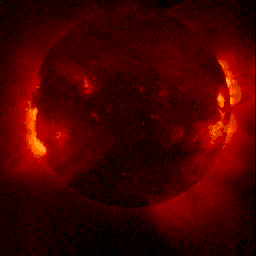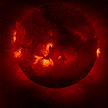The Sun as an X-ray Source

The Sun as seen in X-rays
(from the Yohkoh satellite)
The Sun has a surface temperature of approximately 6000
Kelvin. The solar
surface emits most of its
electromagnetic
radiation in the "visible spectrum",
or the portion of the
electromagnetic
spectrum we can see with our eyes. A 6000 K Sun should be an
extraordinarily weak source of
X-rays. However, we
have known since the 1940s that the Sun is, in fact, a very strong X-ray
emitter. So what is going on here?
The X-rays we detect from the Sun actually come from the solar
corona, not
the solar surface. The corona, the upper layer of the Sun's atmosphere, is
very, very hot (over a million degrees!). Thus, it is an excellent source
of X-rays.
However, the discovery of the hot corona created a big problem for
astronomers and physicists. It is called
The Coronal Heating Problem
Simply stated, the problem is this: The corona is hot, the Sun is not
(relatively speaking). So how does a surface that is about 6000 Kelvin heat
an atmosphere to a million Kelvin? The mechanism via which the solar
corona is heated is not fully understood, even though the issue has been
known and investigated for over 50 years. Many very smart and very talented
people have worked on this problem, including Nobel prize winners. However, the
mystery continues.
What We Do Know

There are cycles of behavior seen in the coronal structure with time scales
on the order of 11 and 22 years. The 12 X-ray
images of the Sun's
atmosphere seen here, obtained between 1991 and 1995 at 90 day increments,
provide a dramatic view of how the corona changes during the waning part of the
solar cycle. The X-ray Sun looks completely different from the Sun we see in the
sky, doesn't it?
Only very hot gases can emit X-rays. The Sun's atmosphere, at millions of
degrees, is hot enough to emit X-rays, while the much cooler surface of the Sun
is not. As a result, an X-ray image reveals a bright glow for the corona and a
black disk for the
surface of the Sun. In the corona, the shape and character of the hot gases are
controlled by the solar
magnetic
fields. There is a clear structure to the bright areas. Many structures
have a filamentary (or thread-like) appearance which seems to "link"
two regions. These filamentary structures are called coronal loops. In
general, the loops are hotter and denser than the areas around them. They are
thus brighter in X-rays.
As the solar activity cycle progresses from maximum to minimum, the Sun's
magnetic field changes from a complex structure to a simpler configuration with
fewer fields. Since the Sun's hot gases are controlled by these fields, the
X-ray images reflect this global change, with an overall decrease in brightness
by a factor of 100!
The hot corona and its structure are not some short-lived, temporary
phenomena. Although the corona is very dynamic with events occurring on time
scales of minutes
(flares), there
are also long-lived structures that have time
scales of months. In fact, the general features of the X-ray emitting corona
have never ceased in the many years we have been observing them! This
"movie" shows you something about the variation of the X-ray
corona.

|
Sun movie (These are BIG files, but worth the time they take
to load!)
|
|
